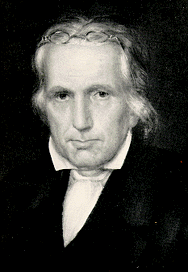Thomas Campbell (minister) facts for kids
Quick facts for kids
Thomas Campbell
|
|
|---|---|
 |
|
| Born | 1 February 1763 |
| Died | 4 January 1854 (aged 90) Bethany, West Virginia, U.S.
|
| Occupation | Minister |
| Known for | Beginning the "Disciples of Christ" movement in America |
|
Notable work
|
Declaration and Address of the Christian Association of Washington (1809) |
| Children | Alexander Campbell |
Thomas Campbell (born February 1, 1763 – died January 4, 1854) was an important Presbyterian minister. He became well-known during a time of religious growth in the United States called the Second Great Awakening.
Thomas Campbell was born in County Down, Ireland. He started a movement to change how religion was practiced in America. His son, Alexander, joined him. Their group was called the "Disciples of Christ." In 1832, they joined with another group led by Barton W. Stone. Together, they formed what is now known as the American Restoration Movement.
Contents
Early Life and Ministry
Thomas Campbell was born in County Down, which is now part of Northern Ireland. He grew up in the Anglican Church. After studying at the University of Glasgow in 1786, he became a minister in the Scottish Seceder Presbyterian Church.
In April 1807, Campbell moved from Ireland to the United States. His doctor had suggested the move for his health. Once in America, Thomas Campbell had some disagreements with other Presbyterians. These disagreements were about certain beliefs and how to give the Eucharist, a religious ceremony.
Starting the Restoration Movement
Thomas Campbell started his part of the movement in 1809. He wrote a document called Declaration and address of the Christian Association of Washington. This happened after the Presbyterian church group had stopped him from being a minister.
In The Declaration and Address, he shared his ideas about the Christian church. He created the Christian Association of Washington in Washington County, Pennsylvania. This group was not a church itself. Instead, it was a group of people who wanted to grow in their faith.
On May 4, 1811, this association became a church. It was governed by its members. They built a church building in Brush Run, Pennsylvania. This church became known as Brush Run Church.
New Beliefs and Practices
As Thomas and his followers studied the New Testament, they decided to start practicing baptism by immersion. This means a person is fully dipped in water during baptism. A nearby group, the Redstone Baptist Association, invited Brush Run Church to join them.
The reformers agreed to join. But they had one condition: they wanted to be "allowed to preach and to teach whatever they learned from the Scriptures." This meant they wanted to follow only what they found in the Bible.
Thomas and his son Alexander worked with the Redstone Baptist Association from 1815 to 1824. Both the Campbells and the Baptists practiced baptism by immersion. They also believed that each church should govern itself.
However, it soon became clear that the Campbells were different from traditional Baptists. Alexander Campbell started a journal called The Christian Baptist. In this journal, he wrote about his ideas for reform. Some Baptist leaders in the Redstone Association found these differences too much. The Campbells expected this conflict. So, in 1824, they moved their church membership to a congregation in the Mahoning Baptist Association.
Ideas and Beliefs
Thomas Campbell was influenced by the ideas of John Locke, a philosopher from the Enlightenment. The Enlightenment was a time when people focused on reason and logic.
In his Declaration and Address, Campbell suggested a way to bring Christians together. He believed they should focus on a few basic ideas that everyone could agree on. These basic ideas were practices that the Bible clearly supported.
Unlike Locke, Campbell wanted a "complete restoration of apostolic Christianity." This means he wanted to bring back the way Christians practiced their faith in the very early days. Thomas believed that religious rules or "creeds" often divided Christians. He also thought the Bible was clear enough for anyone to understand. Because of this, he felt that creeds were not needed.
Campbell combined the Enlightenment idea of unity with older traditions of restoring the church. The Enlightenment helped the Campbell movement in two ways. First, it gave the idea that Christians could unite by finding simple truths. Second, it promoted the idea of a faith based on facts from the Bible.
Key Life Events
- Born on February 1, 1763, in County Down, Ireland.
- Moved to the United States in 1807. He settled in western Pennsylvania.
- In 1809, Campbell published The Declaration and Address of the Christian Association of Washington. This document shared his ideas on how Christians should practice their faith. It helped start the Campbell–Stone Movement. This movement led to the creation of groups like the Christian Church (Disciples of Christ) and the Churches of Christ.
- In 1812, Campbell and his son Alexander began practicing baptism by immersion.
- After his oldest son, Alexander Campbell, became a minister in 1812, Thomas took on more of a supporting role. Thomas was usually less extreme than his son. He helped keep the movement stable.
- Thomas Campbell passed away on January 4, 1854, in Bethany, West Virginia. He was buried next to his wife.
Images for kids
See also
 In Spanish: Thomas Campbell (ministro) para niños
In Spanish: Thomas Campbell (ministro) para niños


